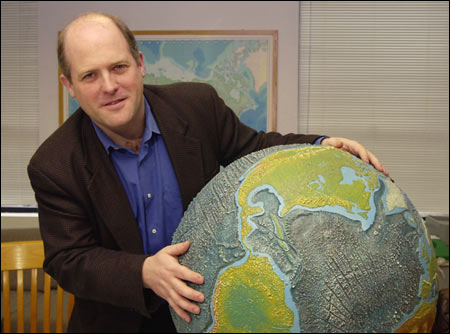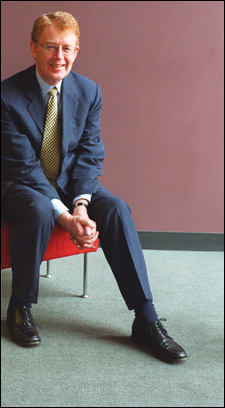Environment brings faculties together
Center reaches out to global community

In studying the world’s environment, Harvard is changing its own environment.
Global and campus challenges have eight of its nine Schools pooling expertise and efforts in ways unprecedented in University history. For three years the Center for the Environment has been drawing on Harvard’s resources in the arts and sciences, business, design, education, government, law, medicine, and public health to increase understanding of the environment and to respond to factors that threaten its stability. Projects range from slowing environmental degradation in China to grappling with the economics of climate change, from a new undergraduate concentration to training executives in business, government, and academia.
The center grew from an idea posed by former Harvard President Derek Bok to a University Committee on Environment, founded in 1991 under the aegis of Neil Rudenstine, Bok’s successor. Michael McElroy, Gilbert Butler Professor of Environmental Studies, chaired the University wide committee, and became director of the center when it was established in April 2001. It will now pass to Daniel Schrag, professor of earth and planetary sciences, who has been serving as acting director.
“Under the leadership of Mike McElroy, the Harvard Center for the Environment has been enormously successful in integrating a wide range of disciplines relating to the study of the environment,” commented Provost Steven Hyman. “The University owes him a debt of gratitude for all he’s done to build this tremendous resource.”
“I very much appreciate the opportunity of working with colleagues from so many different disciplines,” says McElroy, who remains associated with several of the center’s programs. “The experience has been intellectually broadening and personally satisfying.”
“I’ve been very lucky to inherit the center after the hard work of starting it has been done.” Schrag comments. “Mike has been a close friend and mentor. I’m looking forward to working with him and other faculty around the Harvard community to achieve his vision of the best possible scholarship and education on environment.”
Collaboration with China
Even before the center was established, McElroy initiated one of its most

successful projects, an ongoing effort to protect the environment of China, a rapidly growing nation of 1.3 billion people, and to ease the impact of its energy demands on the global environment. “The project brings together a cross section of Harvard scholars, who don’t usually discuss their work with each other every day, and Chinese scholars who enjoy the highest level of support from their government,” McElroy notes.
“Working with a variety of Chinese institutions and other Western universities, we have completed 19 original analyses to launch larger studies that integrate the areas of natural, applied, and medical sciences, economics, urban planning, policy, law, and cultural anthropology,” notes Chris Nielsen, director of the China Project. “We are now working in areas that include a dynamic model of the Chinese economy, hazards of energy-related pollution to health and the economy, and transportation demands and health risks.”
Another gem in Harvard’s environmental crown is a concentration in environmental science and public policy, established in 1992 by the University Committee on Environment. “It was a tough challenge to start a new concentration that includes so many Schools and diverse areas of specialty,” McElroy admits. “The secret of our success has been the ability to intellectually engage both the students and the wide variety of faculty. You have to keep both from getting bored, and both have to learn new things.”
“It’s not an easy concentration,” he continues. “Our students must do tough chemistry and real biology, be mathematically literate and pass courses in economics and government.”
“I thought the hard science requirement would turn off many undergraduates, but it didn’t,” admits Karyn Rogers ’96. The total number of concentrators has stabilized at about 70.
Rogers traveled to Hudson Bay, Canada, to do a thesis investigation of mercury levels in bay-bottom sediments. She is now a senior researcher in atmospheric chemistry at Harvard’s Division of Engineering and Applied Sciences.
McElroy also speaks proudly about the center’s lecture program, which exposes both faculty and students to high-visibility public figures. “It’s not a partisan program,” he insists. “Not all the speakers are pro-environment.”
Lawrence H. Summers, now Harvard’s president, spoke as vice president and chief economist of the World Bank. Former Vice President Albert Gore, and former senator and Undersecretary of State Timothy Wirth also appeared at the podium, as did high level people from the United Nations, China, and Russia. Such guests attend a reception and dinner that includes both faculty and selected students.
Programs and progress
Schrag notes that the center now is planning additional programs in research, education, and outreach. These include offering competitive fellowships for graduate students doing Ph.D. research in fields such as environmental science, economics, policy, and public health.
“We are also developing, through Harvard’s professional Schools, a series of executive training courses for community business and government leaders,” Schrag says. “These will cover the latest and most exciting scholarship in science, economics, and public policy.”
“Training will also be provided to journalists, who play a huge role in shaping how the public understands environmental issues,” Schrag comments. In the organization stage are workshops in environmental science for science writers.
The center offers so-called seed grants to support the early stages of faculty research projects. Because they probe new areas and ideas, such projects are poor candidates for funding from established government agencies and private foundations with specific agendas. Schrag himself received one of these grants to work with Andrew Spielman, a professor of tropical medicine at the Harvard School of Public Health. The two explored the connection between maize cultivation in Africa and the diet of mosquitoes that transmit malaria.
Another program will bring top scholars from different institutions to Harvard. “Such visits would catalyze work in critical areas, helping to make the environmental community here a more active and vibrant place,” Schrag believes. “And we will continue to reach out to the public in general and those in the Boston area in particular. One way to do this will be exhibits and public lectures at the Harvard Museum of Natural History.”
“All of these efforts recognize that human interactions with the environment represent a critical challenge to society now and in the coming decades,” Schrag says. “This challenge involves all parts of society, and Harvard has a leadership role to play in framing the questions to be asked and bringing together scholars, students, and the community at large to help answer them.”
“I am confident,” adds McElroy, “that under the leadership of Dan Schrag, and with committed support from our provost and Dean of the Faculty of Arts and Sciences William Kirby, that the best is yet to come.”




